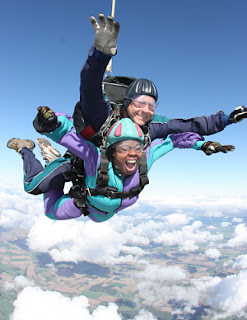 |
| Variations of Skydiving |
In addition to disciplines for which people train, purchase equipment and get coaching/lessons, the recreational skydiver finds ways to just have fun. Today, there are twelve
Variations of Skydiving:
1.
Hit and Rock. "Hit and Rock" is a variant of Accuracy landing devised to let people of varying skill levels compete for fun. "Hit and Rock" is originally from POPS (Parachutists Over Phorty Society). The object is to land as close as possible to the chair, remove the parachute harness, sprint to the chair, sit fully in the chair and rock back and forth at least one time. The contestant is timed from the moment that feet touch the ground until that first rock is completed. This event is considered a race.
2. Freeflying
3. Tracking. Tracking is where skydivers take a body position to achieve a high forward speed, flying their body to achieve separation from other jumpers and cover distance over the ground.
4.
Formation skydiving
5.
Pond swooping. "Pond swooping" is a form of competitive parachuting wherein canopy pilots attempt to touch down at a glide across a small body of water, and onto the shore. Events provide lighthearted competition, rating accuracy, speed, distance and style. Points and peer approval are reduced when a participant "chows", or fails to reach shore and sinks into the water. Some danger involved with pond swooping is when pilots "chow" they land in the water and then the parachute slowly begins to sink. Some divers get tangled in the cord and are dragged to the bottom and drown. To avoid being dragged down, some divers will cut the cord if they sense that they cannot make it across to the shore.
6.
Cross-country. A cross-country jump is a skydive where the participants open their parachutes immediately after jumping, with the intention of covering as much ground under canopy as possible. Usual distance from Jump Run to the dropzone can be as much as several miles.
7.
Camera flying. In "camera flying", a camera person jumps with other skydivers and films them. The camera flier often wears specialized equipment, such as a winged jumpsuit to provide a greater range of fall rates, helmet-mounted video and still cameras, mouth operated camera switches, and optical sights. Some skydivers specialize in camera flying and a few earn fees for filming students on coached jumps or tandem-jumpers, or producing professional footage and photographs for the media. There is always a demand for good camera fliers in the skydiving community, as many of the competitive skydiving disciplines are judged from a video record.
8.
Night jumps. Parachuting is not always restricted to daytime hours; experienced skydivers sometimes perform night jumps. For safety reasons, this requires more equipment than a usual daytime jump and in most jurisdictions requires both an advanced skydiving license (at least a B-License in the U.S.) and a meeting with the local safety official covering who will be doing what on the load. A lighted altimeter (preferably accompanied with an audible altimeter) is a must. Skydivers performing night jumps often take flashlights up with them so that they can check their canopies have properly deployed.
Visibility to other skydivers and other aircraft is also a consideration; FAA regulations require skydivers jumping at night to be wearing a light visible for three miles (5 km) in every direction, and to turn it on once they are under canopy. A chemlight(glowstick) is a good idea on a night jump.
Night jumpers should be made aware of the Dark Zone, when landing at night. Above 100 feet jumpers flying their canopy have a good view of the landing zone normally because of reflected ambient light/moon light. Once they get close to the ground, this ambient light source is lost, because of the low angle of reflection. The lower they get, the darker the ground looks. At about 100 feet and below it may seem that they are landing in a black hole. Suddenly it becomes very dark, and the jumper hits the ground soon after. This ground rush should be explained and anticipated for the first time night jumper.
9.
Stuff jumps. With the availability of a rear door aircraft and a large, unpopulated space to jump over, 'stuff' jumps become possible. In these jumps the skydivers jump out with some object. Rubber raft jumps are popular, where the jumpers sit in a rubber raft. Cars, bicycles, motorcycles, vacuum cleaners, water tanks and inflatable companions have also been thrown out the back of an aircraft. At a certain height the jumpers break off from the object and deploy their parachutes, leaving it to smash into the ground at terminal velocity.
10. Skysurfing
11. Base Jumping
12. Wingsuit flying
Source: http://en.wikipedia.org/wiki/Parachuting




